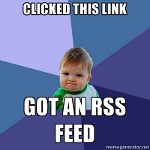From right now in 2005, I see three families of desktop apps that are here for the long haul: First the browser itself, including variations like news readers and music finders, whether P2P or centralized. Second, realtime human-to-human communication, spanning the spectrum from text to voice to video. Third, content creation: PhotoShop, Excel, DreamWeaver, and whatever we’ll need for what we’re creating tomorrow.
A Really Simple social web
1 hour ago

2 comments:
(Disclaimer: Haven't read the linked article yet... It's also 1am.)
While I agree that the second - anything involving large amounts of data over a constant or state-run connection - is probably a "desktop" issue, I don't think it's as clear cut as that. A few haphazard points.
Firstly, the browser "itself" is possibly a subjective issue, with the lines of remote resources and local resources blurred thoroughly (probably a good thing). Is IE/Konqueror a web browser, or is the idea of a web browser simply a subset of a "graphical resource browser" set that extends to take into account *desktop resources*? A blurry point, so I continue.
Secondly, for content creation, why do you include Excel and Dreamweaver here? With recent rumours of a web-based office suite being taken seriously (but denied by Google), just how plausible is a fully-featured on-line spreadsheet? One could, I guess, argue that HTML tables are a "hack" that are being phased out for layout purposes, and that the arbitrary nesting structure of (X)HTML doens't necessarily mesh well with the more rigid 2D matrix of a spreadsheet, so the question (and discussion) has some depth, I feel.
Similarly, what fate off-line web design tools such as Dreamweaver in a world where functionality is (finally) more important than design? If blogs and RSS are the in-things for the last couple of years, and yet neither requires any substantial amount of design (either due to pre-selected templates in the case of many blogs, or a concentration on presenting content in both cases), where does the demand for further progress in design packages come from? Furthermore, the more flexible nature of web browsers - the ability to edit HTML and CSS in real time a la, for example, GreaseMonkey - makes web-based web-editing much more likely, IMHO.
At the moment I would define the split between web-based and non-web-based apps as being between those apps that need vector or pixel-based manipulation. This may or may not change with SVG...
Finally, it's interesting to compare the role of the web browser with the role of other connected applications. It's possible now to hook up various "web" applications via a completely different interface without too much fuss. Say, for example, you wanted a command-line interface to some web database - the calls made by it would be exactly the same as the calls made by an AJAX web application. In this sense, then, maybe it's not the application that's web enabled, but simply the data that's remotely accessible.
What I forgot to mention is this quote from the slashdot article linked to, from Sergey Brin:
"I don't really think that the thing is to take a previous generation of technology and port them directly"
This implies that "legacy" apps are not necessarily the future anyway, and indeed that the web paradigm (perhaps due to its restrictive, yet common nature)offers us a completely different avenue for looking at how we structure and present our data. I need to catch up on some reading (heh) but it seems that Nielsen, Nelson, Brin, etc, are all talking about very different directions to the traditional desktop GUI. Perhaps what we'll see emerge instead is the idea of the II - the "Information Interface", in which manipulating and accessing *your* data is much more important than accessing someone else's pretty content.
Post a Comment